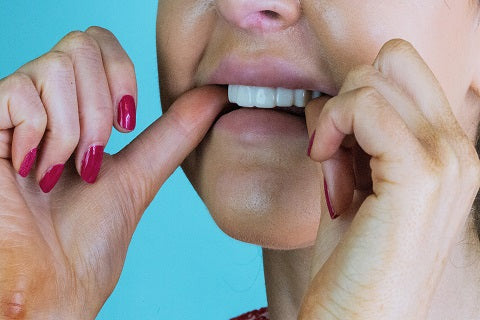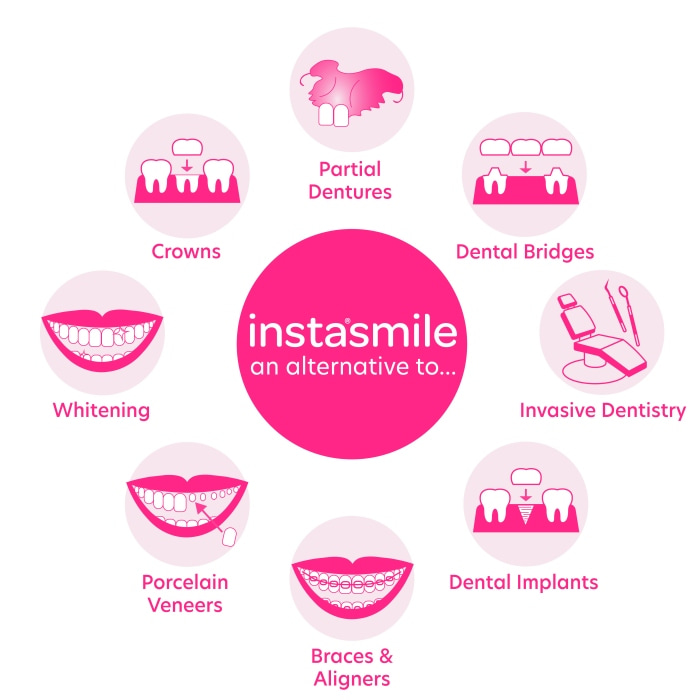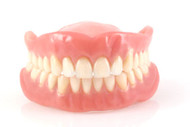Different types of false teeth
False teeth, also known as dentures or partials, are a common form of tooth replacement. False teeth can be used to replace one or more missing teeth, either in upper or lower jaws. Depending on the individual's needs and desires, there are several types of false teeth available:
Complete Dentures
Complete dentures are specifically designed for people that have lost all their teeth. When you're not using your prosthesis, place it in a glass of water by your bed.
People used to make dentures out of hard plastic and porcelain, but for the last thirty years, we've been using a chemically-treated resin that's just as tough as natural teeth. In theory, they're unbreakable; however, in practice, sometimes they do chip. Don't be concerned. Individual artificial teeth can be easily replaced by your dentist.
The artificial teeth are mounted on another piece of gum-colored resin that perfectly matches the gum line. Your dentist will use a soft putty-like material to make an impression of your gums. Even after it's been manufactured, you'll need to try it on and return a few times to make sure it's perfectly shaped to your jawbone and comfortable to wear for long periods of time.
These dentures last a long time but must be replaced after a few years because the patient's jaw loses bone mass as they age, causing the denture to become loose.

Partial Dentures
You don't have to get the rest of your teeth pulled for dentures - partial dentures are designed to be fitted around the remaining, healthy teeth. This solution allows individuals a chance to save their already-healthy pearly whites from painful and costly extractions while still reaping all of the benefits that come with wearing dentures.
Your dentist will ensure that your artificial teeth perfectly match the color of your natural ones, so it'll be virtually impossible to tell the difference. Additionally, they'll securely fasten them in place without an adhesive by utilizing support from other existing teeth. With a precise fit and solid hold, you can flaunt those pearly whites with confidence.
If you're considering partial dentures, a highly popular option is the removable type. As its name suggests, it can be taken out for cleaning or replacement as necessary. Typically made from either metal frames or flexible plastic materials, these are easy to use and care for in everyday life.
If you're on a budget, then consider purchasing a flipper or temporary partial denture. This option is characterized by its acrylic base and metal clasp structure, yet will only provide short-term results due to its fragility, discomfort, and insecurity as compared with other solutions. Therefore it's best used when your resources are limited.
The last choice for this type of dental procedure is fixed partial dentures or bridges. By opting to choose this, multiple crowns will be permanently affixed in your mouth; they are not meant to be taken out.
Dental Implant
Implants are the most common type of partial denture. The procedure is new, and it is the closest you can get to getting your original tooth back.
Even like natural teeth, dental implants have a root. The root is a titanium screw that holds the artificial tooth in place.
The screw is inserted into the jawbone through a hole drilled there. The procedure necessitates the use of local anesthesia and extensive x-ray imaging. If the dentist deems it necessary, an overnight stay in a hospital may be recommended, but this is uncommon.
The screw is literally planted in the jaw, and the bone is allowed to grow back and firmly clasp the screw for a few weeks.
This implant's top surface can be used to place a crown. The final product is more aesthetically pleasing than the original tooth it replaces.
Removable Denture
Removable dentures, also known as partial dentures, are used when some of the patient's natural teeth remain. A removable denture is a prosthesis with artificial teeth attached to a frame that can be easily removed from the mouth.
Two clasps extend from the structure on either side, anchoring themselves on adjacent teeth.
The dentist determines the anchor hook's design and placement. The concept has been around for decades and is relatively inexpensive to obtain.
Its disadvantage is that it causes some discomfort while being used. There may be no pain, but you always have the feeling that something is stuck in your mouth.
Acrylic is the preferred material for these, and they are held in place by suction. Between these and the mouth, saliva forms a thin film that keeps them in place.

Bridge
Dentists use bridges when only one or two teeth are missing in a row. For more than a century, dental bridges have been in use. The cantilever and traditional designs are the most popular. This design determines how the artificial tooth's load is distributed to the adjacent teeth, and both appear identical from the outside.
Hard resin or ceramic is used for the crown. After precise measurements, a bridge is built to order. They attach with a snap and open with a push. They are quite perfect in terms of aesthetics and chewing until the adjacent teeth beginto age.
Veneers
Celebrities love showing off their dazzling smiles on camera, and they often opt for veneers to perfect those grins. These thin slivers of porcelain are fitted over the teeth; though some prefer a shade that matches their natural tooth color, more meticulous individuals usually go for the most radiant bright hues available.
There are different prices for porcelain veneers, but for the most part, they can reach $1,000 to $2,500 per tooth.
No matter the type of veneers you select, they can be either affixed directly over your existing teeth or necessitate grinding down parts of them to create room for more permanent ones. While this latter option is typically the most visually appealing and effective choice, it may sometimes pose various difficulties.
Looking for a wallet-friendly yet convenient alternative to dentures? Look no further than clip-on veneers – the growing trend that is changing lives! Removable veneers provide an easy way for people of all ages and backgrounds to get their confidence back.
Why Choose Clip-On Veneers?
The price of this device is incredibly cost-effective, and it gives you a full set of stunning teeth without needing to spend too much money. Unlike dentures, you don't have to go to the dentist for removable veneers as they can be ordered online conveniently with an easy process. Custom-made in accordance with your teeth's shape and size, it's definitely a great way to save both time and money.
Clip-on veneers offer a budget-friendly solution that looks just like natural teeth; thanks to their cutting-edge technology. Not only do removable veneers feel and finish as if they were your own healthy-looking teeth, but with the same shade and shape as genuine ones! These clip-on wonders are so realistic in fact, most people would never even suspect you had them on.
Frequently Asked Questions
When should you go to the dentist?
If you have dentures (even complete dentures), you should see your dentist on a regular basis so they can check for any problems.
Your dentures should last for several years if taken proper care of.
However, as your gums and jawbone shrink, your dentures may no longer fit as well as they once did, causing them to become loose or worn.
How are dentures fitted?
If all of your upper or lower teeth must be removed, or if your old complete denture needs to be replaced, a full denture will be fitted.
You won't be without teeth for long because the denture will be fitted as soon as your teeth are removed. The denture will fit over your gums and jawbone snugly.
However, if you get dentures right after losing several teeth, the gums and bone will change shape quickly, and the dentures will need to be relined or remade after a few months.
Your gums may need to heal and change shape for several months before dentures can be fitted in some cases.
Why should I have my missing teeth replaced?
One reason is your appearance. Another factor is that a missing tooth can cause more strain on the teeth on either side.
Because the teeth next to the gap can lean into the gap and change the way the upper and lower teeth bite together, a gap can also affect your 'bite.' This can lead to food becoming trapped in the gap, causing tooth decay and gum disease. You can also check out denture payment plans. At Instasmile we offer an alternative to dentures with our snap-on veneers.






 UK
UK
 USA
USA
 Australia
Australia

